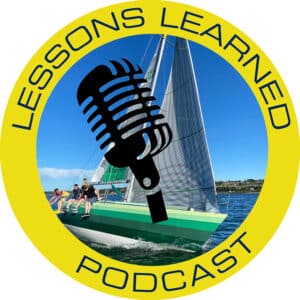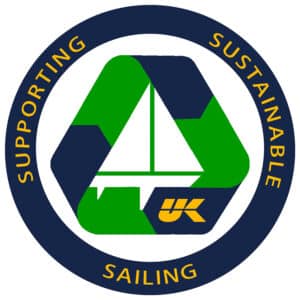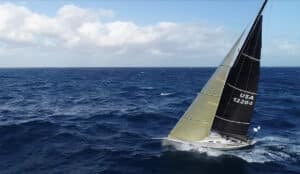Darren and Amanda Seltzer set off to sail around the world on their 39-foot Amel Sharki PANDA just as the world went into the pandemic lock-down. Instead of going from the the Caribbean to the Panama Canal and then on to the South Pacific, they had to to change plans. Here is the latest installment from their still developing voyage.
“I wonder if even the Viking’s would have gone out today?” was the question that was running through my mind as it was blowing 30-35 knots from the north, straight down the east coast of Greenland. We were securely anchored in Prins Christian Sund when we decided to depart for our Atlantic crossing direct to Scotland about 1200NM away. Although the conditions weren’t ideal, it was overall a moderately good window; the weather is never perfect in these parts. The systems are always fast moving and relatively spontaneous, making it challenging to confidently declare a departure day.
That morning we set out and pointed our Amel Sharki’s bow due east, past some very large icebergs, we began to experience the type of sea state that results from steady Force 7 winds. We were in solid four-meter (12ft) swell with the occasional peak 1-2 meters (3-6ft) taller. Bang! Thud! These were constant sounds as breaking waves careened the side of our hull, creating a spectacular splash covering our decks with icy cold Atlantic seawater.
In no time, the first consequences of these conditions became apparent: Amanda lurched down the leeward side over the cockpit and made a sizable donation to King Neptune. Yet another first for either of us, experiencing the worst symptom of seasickness.
After several days, the conditions became much milder; a very light, nearly calm, forecast set in. The sea was virtually a pond and we had to motor across several hundred miles. One night, we experienced the most breathtaking sights we’ve seen at sea – the Northern Lights. The Aurora Borealis danced magnificently from the heavens, creating a show without obstruction from clouds, lights, or even a moon, reflected in the still waters. It was difficult to discern where the ocean ended and the sky began. We were completely awestruck.
The next day, our tranquil sea state turned into steady chop as an easterly headwind developed. Our strategy was to sail on port tack into the center of this minor low pressure system, so that we could later tack to a starboard to have a slightly more favorable wind direction. “I’m going to go forward and investigate why our Genoa has lost some halyard tension,” I said as we languished in the windlass area in the middle of the low. I soon realized, “We have a problem. Our forestay chainplate has broken!” It was a U-shaped design where the forward attachment point had severed and subsequently bent 10-20mm, creating a sag in our forestay. We were 600NM from Scotland, 300NM from Iceland, and only 150NM of fuel remained.
Being brought up racing go-karts and later cars, I was accustomed to last-minute duct tape and zip-tie repairs. I didn’t hesitate and quickly formulated a plan to relieve the stress on the remaining part. It only needed to hold for a while longer. Amanda and I got to work with some Dyneema loops, 12mm double braided line, and used the windlass motor’s winch to create quite a strong attachment. Even if the forestay failed completely, at least there was still some attachment to the boat and thus minimal chance for serious damage to the rig or other equipment. We then set the staysail, rolled in the genoa, and set for a close winded beat out other side of the low. “Nothing like a 25kt headwind and raging sea to test our fix eh?” I yelled to Amanda as she took her shift. She faced several serious thunderstorms. The radar lit-up with the intensity and the rain poured.
We were relieved when the storm conditions finally subsided after four days and our jury rig was still holding. After the storms, we got some grand sailing conditions at last; 15-20kts on the beam for the last two days that swept us nicely along to Scotland, albeit under reduced sail. Landfall on the northern tip of the Hebrides 12 days after departing the icy waters of Greenland was a magical site. Not only did our mend hold, but we had just finished our great trip across the Atlantic Ocean! Our longest sail yet!
Docked safely in Stornoway harbor, we could now rest, repair, and reflect on the last seven months of cruising. We had covered 6,500NM in that time. That makes an average of nearly 1000NM/month. If this was our ‘introduction’ to cruising, I think we passed the test with some serious experience gained.





That broken U joint looks a little light for a 39 foot boat. Looks like stress corrosion
I carry an assortment of shackles on board for such emergencies. Some stainless and some galvanized.
Not trying to be a Monday morning quarterback but for others. Spare parts!
That broken U joint looks a little light for a 39 foot boat. Looks like stress corrosion
I carry an assortment of shackles on board for such emergencies. Some stainless and some galvanized.
Not trying to be a Monday morning quarterback but for others. Spare parts!
Fabulous !!
Fabulous !!